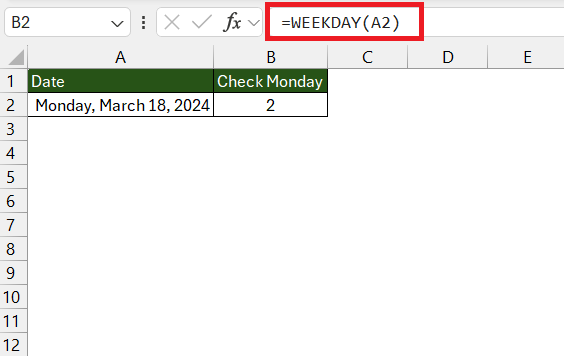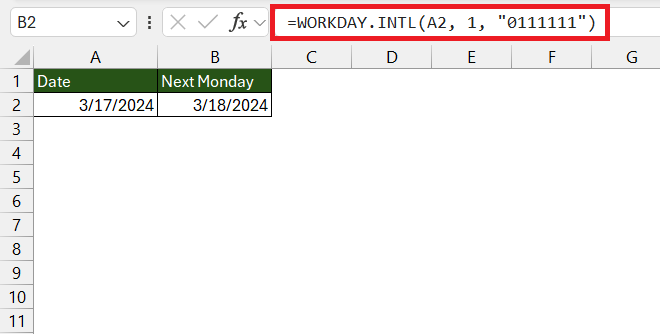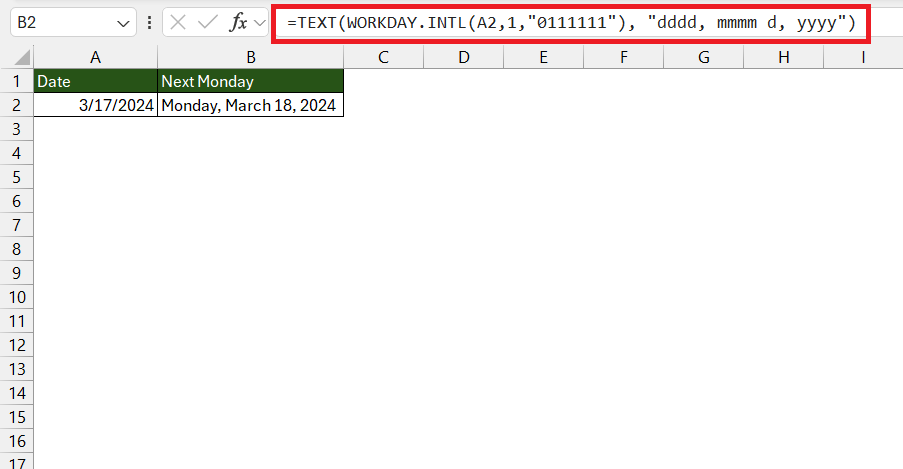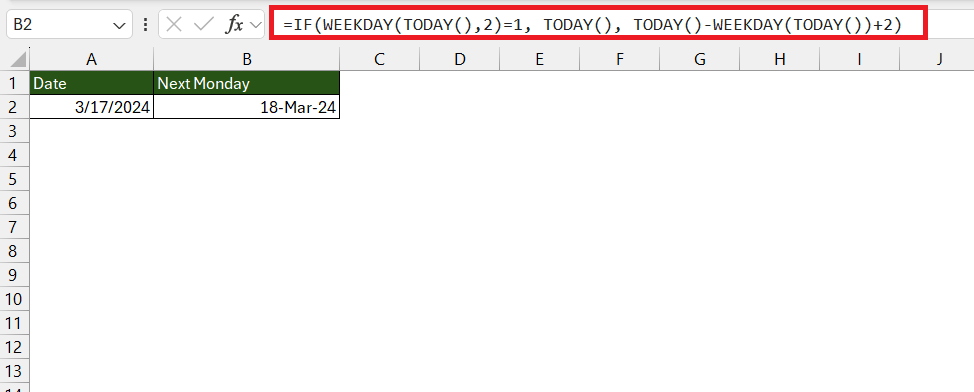Microsoft Excel is more than spreadsheet software; it’s a vital tool for efficient time and schedule management. This guide will show you how Excel’s date functions can streamline the task of scheduling, particularly in finding the date for the next Monday, a crucial need for professionals aiming for a productive week ahead.
Key Takeaways
- WEEKDAY Function: The foundation for date-related tasks in Excel, identifying how far or close the next Monday is from any given date.
- WORKDAY and WORKDAY.INTL Functions: These functions exclude weekends and holidays from date calculations, with WORKDAY.INTL offering custom definitions of weekends for flexible scheduling.
- Enhanced Readability with TEXT Function: Convert dates into easy-to-read formats without losing the value’s integrity, making schedules clearer for everyone.
- Automating Weekly Reports: Set up Excel sheets to automatically reflect the most recent Monday’s data, streamlining weekly report preparations and ensuring consistent updates.
Table of Contents
Introduction
The Magic of Excel in Scheduling
Excel isn’t just a spreadsheet software; it’s a powerful tool for managing your time and schedules efficiently. With Excel’s date functions, one can transform raw figures into meaningful timelines and plans. Let’s dive into how Excel can simplify the often arduous task of date scheduling without fuss.
Why Knowing the Next Monday Matters
For many professionals, Mondays signify the start of a new workweek, full of fresh goals and deadlines. Knowing the date of the next Monday helps in aligning weekly tasks and ensures that project timelines are accurate. It also allows teams to coordinate their efforts for a productive week ahead, facilitates setting up weekly meetings with precision, and keeps everyone synced with the corporate schedule. Understanding how to quickly find next Monday’s date in Excel can hence be a valuable skill in your time management toolkit.
Understanding Excel Date Functions
WEEKDAY Function: Your Starting Point
The WEEKDAY function in Excel is your go-to starter for any date-related operation. It returns a number from 1 to 7, representing days of the week, starting with Sunday by default. When you’re targeting a specific day, like Monday, WEEKDAY can tell you how far away that day is from a given date. By inputting the date in question and configuring the function properly, you can determine if it’s a Monday (represented as 2 when starting the week on a Sunday) or how many days you need to leap to find the next one.
WORKDAY and WORKDAY.INTL Functions for Date Manipulation
The WORKDAY and WORKDAY.INTL functions in Excel are your allies when manipulating dates to exclude weekends and even factor in holidays. The WORKDAY function traditionally skips Saturdays and Sundays, propelling you forward or backward to the nearest working day from a stated date. If your scheduling requires more flexibility, say your workweek isn’t the conventional Monday to Friday, WORKDAY.INTL is the hero you need.
WORKDAY.INTL is used to calculate a date that is a specific number of working days away from a start date, excluding weekends and optionally skipping any dates listed as holidays. This intuitive function allows you to define which days are considered weekends via numeric or binary codes, offering versatility in managing unconventional work calendars.
With WORKDAY.INTL, you’re not limited to the standard weekend. For instance, to find the next Monday regardless of the start date being on a Monday or any other day, you could use the custom code “0111111”:
=WORKDAY.INTL(A1, 1, "0111111")
Here, the set of zeros and ones uniquely represent the days of the week starting from Monday, where 0 means a working day and 1 designate the weekend—allowing for a level of customization that adapts to various professional needs.
Advanced Tips and Tricks
Incorporating Text Functions for Enhanced Readability
While dealing with dates in Excel, readability can occasionally take a back seat to functionality, but it doesn’t have to be that way. The TEXT function emerges as a powerful ally, enabling you to convert dates into a more readable string format while maintaining the original value’s integrity.
For instance, if you’ve calculated next Monday’s date and you wish to display it as “Monday, March 1, 2023,” you can use the TEXT function:
=TEXT(WORKDAY.INTL(A2,1,”0111111″), “dddd, mmmm d, yyyy”)
This nifty function takes your date and formats it according to the string provided, making it much easier for you and others to read directly in the cell without having to refer to any date headers or footnotes.
When reports or schedules are shared among team members, having dates displayed in a clear and consistent manner can significantly reduce misunderstandings and miscommunications.
Automating Weekly Reports to Land on Mondays
Setting up your Excel reports to automatically update and reflect information as of the most recent Monday can streamline your workflow remarkably. Many businesses prefer to have their weekly reports ready on Monday to assess the previous week’s performance and make data-driven decisions for the week ahead.
To automate this process, use the IF and WEEKDAY functions to determine if today is a Monday or if the report should refer to the previous one. Here’s an example formula that checks if today is a Monday; if not, it rolls back to the most recent Monday:
=IF(WEEKDAY(TODAY(),2)=1, TODAY(), TODAY()-WEEKDAY(TODAY())+2)
With this in place, the report uses the most recent Monday’s data without the need for manual adjustments each week.
This strategy is beneficial not just for internal reviews but also for maintaining regular communication with clients or stakeholders, ensuring that they receive timely and consistent updates.
FAQs
How can I find the date of next Monday in Excel?
To find the date of next Monday in Excel, you can use the formula =A2+(7-WEEKDAY(A2,2)+1), where A2 contains the initial date from which you want to calculate the next Monday. After entering the formula in a blank cell, drag the fill handle across the cells where you want the next Monday’s date to be displayed, and Excel will automatically calculate and fill in the dates for you.
Can these methods be applied to calculate any day of the week?
Yes, these methods can be adapted to calculate any day of the week in Excel. The key is to modify the formulas to target the number assigned to the desired day by adjusting parameters within functions like WEEKDAY, WORKDAY, or WORKDAY.INTL. You can customize formulas by changing the number of days added or the custom weekend string based on the outcome you’re seeking, whether it’s a Tuesday, Friday, or any other weekday.
How do you find the next Tuesday in Excel?
To find the next Tuesday in Excel, use a formula based on the WEEKDAY function. If A1 contains your start date:
=A1 + MOD(3 - WEEKDAY(A1, 3), 7)
This calculates how many days to add to A1 to get to the next Tuesday, which is represented by 3 in Excel when using the WEEKDAY function with return_type set to 3 (Tuesday = 3, Wednesday = 4, and so on).
What should I do to calculate the first date of the following month?
To calculate the first date of the following month in Excel, you can use the EOMONTH function to get the last day of the current month and then add one day:
=EOMONTH(A1, 0) + 1
This will give you the first day of the month immediately after the month in which the date in A1 falls.
What formula do I need so the orders greater than two are moved into the following week?
If you’re trying to move orders of a certain limit into the following week, you can use a formula that adjusts the date based on the order quantity. Assuming that A1 contains the order quantity and B1 the original date:
=IF(A1 > 2, B1 + (8 - WEEKDAY(B1, 2)), B1)
This formula checks if the quantity in A1 exceeds two. If it does, it calculates a date for the following week, otherwise, it keeps the original date.
John Michaloudis is a former accountant and finance analyst at General Electric, a Microsoft MVP since 2020, an Amazon #1 bestselling author of 4 Microsoft Excel books and teacher of Microsoft Excel & Office over at his flagship MyExcelOnline Academy Online Course.











